 |
| January 20, 2015 | Volume 11 Issue 03 |
Mechanical News & Products
Designfax weekly eMagazine
Archives
Partners
Manufacturing Center
Product Spotlight
Modern Applications News
Metalworking Ideas For
Today's Job Shops
Tooling and Production
Strategies for large
metalworking plants
How ball spline coatings enhance performance and extend component life
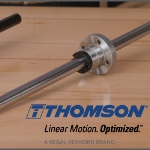 According to Thomson, "Precision ball splines have gained popularity as an ideal choice for applications that require low-friction linear and rotary motion. These components, which utilize a single splined shaft, enable complex movements in multiple directions." But how do you keep these ball splines performing at their peak for longer? Coatings can do the trick, and Thomson has three of them: black oxide, hard chrome plating, and nickel plating. Learn more about these coatings and which one makes the most sense for your precision ball spline solution.
According to Thomson, "Precision ball splines have gained popularity as an ideal choice for applications that require low-friction linear and rotary motion. These components, which utilize a single splined shaft, enable complex movements in multiple directions." But how do you keep these ball splines performing at their peak for longer? Coatings can do the trick, and Thomson has three of them: black oxide, hard chrome plating, and nickel plating. Learn more about these coatings and which one makes the most sense for your precision ball spline solution.
View the video.
Key factors for ball screw applications
 Learn the six key factors that should be considered when specifying ball screw assemblies in motion control applications. PCB Linear gathered a panel of experts in the field of linear motion to concentrate on this important topic -- particularly when it comes to the company's new miniature ball screw product line. Learn about precision and accuracy, orientation, speed and acceleration, duty cycle, linear motion travel, and load capacity. Podcast available too.
Learn the six key factors that should be considered when specifying ball screw assemblies in motion control applications. PCB Linear gathered a panel of experts in the field of linear motion to concentrate on this important topic -- particularly when it comes to the company's new miniature ball screw product line. Learn about precision and accuracy, orientation, speed and acceleration, duty cycle, linear motion travel, and load capacity. Podcast available too.
Read the PCB Linear blog.
3D printer uses pellet extrusion system instead of filament
 The latest addition to 3D Systems' industry-leading portfolio of EXT Titan Pellet systems is the EXT 800 Titan Pellet. With a build volume of 800 x 600 x 800 mm, this thermoplastics 3D printer harnesses the speed, reliability, and efficiency of the company's large-format pellet systems in a more compact unit with lower upfront investment. Use this machine to fabricate more modestly sized functional prototypes, tooling, fixtures, sand casting patterns, thermoforming molds, and end-use parts. Markedly faster than competing FFF and FDM printers, and up to 10X reduced material costs compared to filaments.
The latest addition to 3D Systems' industry-leading portfolio of EXT Titan Pellet systems is the EXT 800 Titan Pellet. With a build volume of 800 x 600 x 800 mm, this thermoplastics 3D printer harnesses the speed, reliability, and efficiency of the company's large-format pellet systems in a more compact unit with lower upfront investment. Use this machine to fabricate more modestly sized functional prototypes, tooling, fixtures, sand casting patterns, thermoforming molds, and end-use parts. Markedly faster than competing FFF and FDM printers, and up to 10X reduced material costs compared to filaments.
Learn more.
Test your knowledge: High-temp adhesives
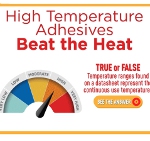 Put your knowledge to the test by trying to answer these key questions on how to choose the right high-temperature-resistant adhesive. The technical experts from Master Bond cover critical information necessary for the selection process, including questions on glass transition temperature and service temperature range. Some of the answers may surprise even the savviest of engineers.
Put your knowledge to the test by trying to answer these key questions on how to choose the right high-temperature-resistant adhesive. The technical experts from Master Bond cover critical information necessary for the selection process, including questions on glass transition temperature and service temperature range. Some of the answers may surprise even the savviest of engineers.
Take the quiz.
World's first current-carrying fastening technology
 PEM® eConnect™ current-carrying pins from Penn-Engineering provide superior electrical connections in applications that demand high performance from internal components, such as automotive electronics. This first-to-market tech provides repeatable, consistent electrical joints and superior installation unmatched by traditional fastening methods. Features include quick and secure automated installation, no hot spots or poor conductivity, and captivation options that include self-clinching and broaching styles.
PEM® eConnect™ current-carrying pins from Penn-Engineering provide superior electrical connections in applications that demand high performance from internal components, such as automotive electronics. This first-to-market tech provides repeatable, consistent electrical joints and superior installation unmatched by traditional fastening methods. Features include quick and secure automated installation, no hot spots or poor conductivity, and captivation options that include self-clinching and broaching styles.
Learn more about eConnect pins.
New flat quarter-turn clamping fastener
 IMAO Fixtureworks has expanded its One-Touch Fastener lineup to include a new quarter-turn clamping fastener that features an innovative flat design and is ideal for clamping in limited spaces. The QCFC flat quarter-turn fastener features a recessed body that protrudes only 2 mm from the mounted surface, a knob that rests flush inside the body, visible ON and OFF markings for safety, and an audible click when fully turned to clamped or unclamped position.
IMAO Fixtureworks has expanded its One-Touch Fastener lineup to include a new quarter-turn clamping fastener that features an innovative flat design and is ideal for clamping in limited spaces. The QCFC flat quarter-turn fastener features a recessed body that protrudes only 2 mm from the mounted surface, a knob that rests flush inside the body, visible ON and OFF markings for safety, and an audible click when fully turned to clamped or unclamped position.
Learn more.
Bellows and disc couplings with higher torque capacity
 Ruland Manufacturing now offers bellows and double disc couplings with bore sizes up to 1-3/4 in. or 45 mm for use in systems with torque up to 1,400 in.-lb (158 Nm). High-torque applications in precision semiconductor, solar, conveyor, and factory automation applications often use these shaft sizes. Ruland disc and bellows couplings accommodate all forms of misalignment, are zero-backlash, and have a balanced design for reduced vibration at speeds up to 10,000 rpm.
Ruland Manufacturing now offers bellows and double disc couplings with bore sizes up to 1-3/4 in. or 45 mm for use in systems with torque up to 1,400 in.-lb (158 Nm). High-torque applications in precision semiconductor, solar, conveyor, and factory automation applications often use these shaft sizes. Ruland disc and bellows couplings accommodate all forms of misalignment, are zero-backlash, and have a balanced design for reduced vibration at speeds up to 10,000 rpm.
Learn more.
Simplify your designs with slewing ring bearings
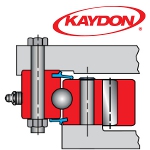 According to Kaydon Bearings, "A slewing ring bearing has rolling elements designed to create a reactive moment within the bearing's dimensions envelope to oppose applied (overturning) moment load," so you can use one bearing instead of two, reducing the height requirements, and even improve performance. Slewing ring bearings can also simplify a drive system by utilizing gear teeth on the inner or outer race. Learn all about slewing ring bearings in this informative article.
According to Kaydon Bearings, "A slewing ring bearing has rolling elements designed to create a reactive moment within the bearing's dimensions envelope to oppose applied (overturning) moment load," so you can use one bearing instead of two, reducing the height requirements, and even improve performance. Slewing ring bearings can also simplify a drive system by utilizing gear teeth on the inner or outer race. Learn all about slewing ring bearings in this informative article.
Read the Kaydon whitepaper.
Jet valve for ultra-small dispensing
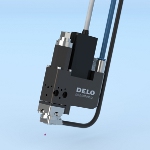 DELO's DELO-DOT PN5 LV pneumatic jet valve is designed for micro-dispensing low-viscosity adhesives and other media in miniaturized applications. Thanks to its compact design, it also requires very little space to install in production systems. Interchangeable nozzles with different diameters and a flexible, adjustable plunger stroke ensure precise and reliable applications at different droplet sizes. Volumes of as low as 1 nl can be achieved, which corresponds to droplet diameters of 250 µm or less.
DELO's DELO-DOT PN5 LV pneumatic jet valve is designed for micro-dispensing low-viscosity adhesives and other media in miniaturized applications. Thanks to its compact design, it also requires very little space to install in production systems. Interchangeable nozzles with different diameters and a flexible, adjustable plunger stroke ensure precise and reliable applications at different droplet sizes. Volumes of as low as 1 nl can be achieved, which corresponds to droplet diameters of 250 µm or less.
Learn more.
Stainless steel constant-torque flush-mount hinge
 Southco has introduced a flush-mount version of its popular and durable E6 constant-torque hinge. Its low-profile, corrosion-resistant package makes it an ideal solution for maximizing security, longevity, and aesthetics. It offers high torque for demanding applications while maintaining its low profile. Lots of uses.
Southco has introduced a flush-mount version of its popular and durable E6 constant-torque hinge. Its low-profile, corrosion-resistant package makes it an ideal solution for maximizing security, longevity, and aesthetics. It offers high torque for demanding applications while maintaining its low profile. Lots of uses.
Learn more.
Claw vacuum pump for industrial applications
 Vacuum expert Leybold has added a new model to its proven CLAWVAC dry claw vacuum pump series: the CLAWVAC CP B. This innovative, rough vacuum pump, designed for robust processes including food processing, material handling, and environmental industries, is powerful, energy efficient, and easy to clean. The intuitive handling of this unit is mainly due to its functional design, which features a pair of claws that rotate in the cylinder with no contact or wear. Its separate gearbox prevents oil contamination. The design ensures short downtimes and long service intervals: 20,000 hr between oil changes and up to 48,000 hr between general overhauls.
Vacuum expert Leybold has added a new model to its proven CLAWVAC dry claw vacuum pump series: the CLAWVAC CP B. This innovative, rough vacuum pump, designed for robust processes including food processing, material handling, and environmental industries, is powerful, energy efficient, and easy to clean. The intuitive handling of this unit is mainly due to its functional design, which features a pair of claws that rotate in the cylinder with no contact or wear. Its separate gearbox prevents oil contamination. The design ensures short downtimes and long service intervals: 20,000 hr between oil changes and up to 48,000 hr between general overhauls.
Learn more.
DualVee linear guides and tracks used in warehousing
 See how Bishop-Wisecarver's DualVee® motion tech can add huge benefits to warehousing operations. This video highlights two applications: a manual storage and retrieval system and an automated storage and retrieval system of long aerospace-grade carbon fiber in sub-zero temps. Patented DualVee guides and tracks keep operations running smoothly.
See how Bishop-Wisecarver's DualVee® motion tech can add huge benefits to warehousing operations. This video highlights two applications: a manual storage and retrieval system and an automated storage and retrieval system of long aerospace-grade carbon fiber in sub-zero temps. Patented DualVee guides and tracks keep operations running smoothly.
View the video.
Build-to-order knobs and hand hardware
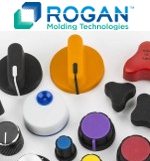 Rogan Corp.'s innovative use of two-shot plastic injection and insert molding has been providing customers with high-quality plastic clamping knobs, levers, and control knobs for almost 90 years. Rogan offers concurrent engineering, product design, and assistance in material selection to ensure customer satisfaction for standard or customized parts, with a focus on cost optimization and on-time delivery. Custom colors, markings, decorative inlays, or engineered materials to meet special requirements, such as adding extra strength or utilizing flame-retardant material, are all offered.
Rogan Corp.'s innovative use of two-shot plastic injection and insert molding has been providing customers with high-quality plastic clamping knobs, levers, and control knobs for almost 90 years. Rogan offers concurrent engineering, product design, and assistance in material selection to ensure customer satisfaction for standard or customized parts, with a focus on cost optimization and on-time delivery. Custom colors, markings, decorative inlays, or engineered materials to meet special requirements, such as adding extra strength or utilizing flame-retardant material, are all offered.
Learn more.
Slewing ring bearing made of wood and plastic
 The PRT-02-30-WPC slewing ring bearing is another step forward by igus toward integrating renewable raw materials into industrial production. Made of 50% wood and 50% high-performance plastics, the cost-effective and lubrication-free slewing ring bearing balances strength and durability with a proven low CO2 footprint. The materials incorporate solid lubricants, making the new slewing ring bearing smooth running and maintenance-free.
The PRT-02-30-WPC slewing ring bearing is another step forward by igus toward integrating renewable raw materials into industrial production. Made of 50% wood and 50% high-performance plastics, the cost-effective and lubrication-free slewing ring bearing balances strength and durability with a proven low CO2 footprint. The materials incorporate solid lubricants, making the new slewing ring bearing smooth running and maintenance-free.
Learn more.
Flex Locators for quick fixture changeover
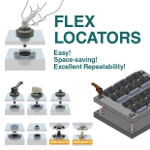 Flex Locators from Fixtureworks are designed for quick changeover of small and large fixtures, automation components, and more. They are ideal for applications that require frequent disassembly, providing excellent repeatability for locating and clamping in a single operation. Manual and pneumatic versions are available. Just turn the handle, knob, or screw!
Flex Locators from Fixtureworks are designed for quick changeover of small and large fixtures, automation components, and more. They are ideal for applications that require frequent disassembly, providing excellent repeatability for locating and clamping in a single operation. Manual and pneumatic versions are available. Just turn the handle, knob, or screw!
View the video.
Carnegie Mellon lunar rover wows XPRIZE judges, wins milestone prize
By Byron Spice, Carnegie Mellon University
The Google Lunar XPRIZE announced Dec. 16, 2014, that Andy, a four-wheeled lunar rover designed and built by Carnegie Mellon University, is the winner of a Milestone Prize for mobility after judges concluded it is thus far the only robot among the competing teams to meet development benchmarks for flight readiness.

Other teams continue to contend for Milestone Prizes, which will be awarded Jan. 26, 2015, in San Francisco, but the CMU team is the first and only team to meet the Milestone mobility objectives thus far, XPRIZE said. Likewise, CMU's partner, Pittsburgh's Astrobotic Technology, is the first winner of a Milestone Prize in the imaging subsystem category.
"Andy has proven to be a tough, smart, sure-footed machine," said William "Red" Whittaker, professor of robotics, who led a team of about 50 students, faculty, and staff members from across the CMU campus to create the rover. "We've shaken it to simulate launch forces, driven it through moon dirt, and exposed it to the extremes of lunar temperatures among many, many tests. Our team and our machine faced a rigorous evaluation by world-class judges and came out on top."
The Mobility Milestone Prize includes a $500,000 cash award.
"We don't do anything just for a prize," Whittaker added, "but when a check like this comes our way, we cash it." The prize money will be used to continue Andy's development.
The robot can scramble around giant moon pits, explore lunar caves, or seek polar ice.
Carnegie Mellon is building the rover as it works in partnership with Astrobotic Technology to win the $20 million-plus Google Lunar XPRIZE by landing and operating a robot on the moon. Astrobotic, a CMU spinoff, is developing commercial hardware and services to support space exploration. In addition to the imaging technology for which it won a Milestone Prize, Astrobotic also is developing the Griffin landing craft that will deliver Andy to the moon.
The Milestone Prizes created by Google and the XPRIZE Foundation included three categories: landing system, mobility subsystems, and imaging subsystems. Astrobotic is continuing to pursue the Milestone Prize for landing systems. Other teams still in the running for Milestone Prizes include Hakuto (Japan), Team Indus (India), Moon Express (U.S.), and Part-Time Scientists (Germany).
XPRIZE officials also announced that they have extended the deadline for the competition until Dec. 31, 2016. At least one team must provide documentation of a scheduled launch by Dec. 31, 2015, for all of the teams to move forward in the competition, the officials said.
"We feel confident that we can land on the moon in 2016 and show that a private company can set the course for future lunar exploration," said John Thornton, Astrobotic's CEO.
Planetary Robotics Team Introductions from Carnegie Mellon Lunar Team on Vimeo.
To receive the mobility prize, the CMU team had to demonstrate that Andy could survive the vacuum, high radiation, and extreme cold of the moon. The team also had to show that the robot could complete -- and could prove that it completed -- a 500-m traverse on the lunar surface, one of the conditions for winning the Google Lunar XPRIZE.
Andy's prize-winning features include:
- A wide stance, low center of gravity, and high belly clearance combine for unprecedented stability, slope climbing, and straddling of rocks.
- A soft footprint -- weighing less than 10 lb on the moon -- and wide wheels give Andy superior mobility, while a novel suspension provides strong pulling power.
- A new method for combining landing imagery with 3D path reconstruction data to plan and document Andy's exploration route.
- Innovative software that, combined with redundant electronic components, achieves high reliability of electronic systems despite the moon's high radiation levels.
Andy, which derives its moniker from university namesakes Andrew Carnegie and Andrew Mellon, was developed with technical expertise and resources contributed from across the university, including the School of Computer Science, the College of Engineering, the College of Fine Arts, and the Mellon College of Science.
Whittaker said many team members contributed long hours to the creation of Andy. Notable among them were Jon Anderson and Curtis Boirum, both master's degree students in robotics; Joe Bartels, Nate Otten, and Heather Jones, Ph.D. students in robotics; Luke Metro, a sophomore electrical and computer engineering major; John Mann, a junior computer science major; and Jay Jasper, a master's degree student in mechanical engineering.
More information about Andy and Carnegie Mellon's Lunar Exploration Initiative is available online at lunar.cs.cmu.edu
Published January 2015.
Rate this article
View our terms of use and privacy policy


